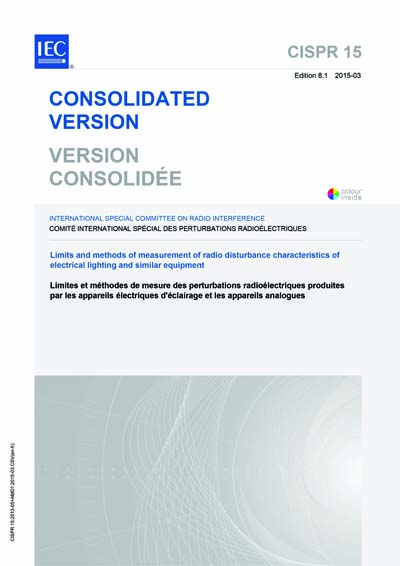Historical
CISPR 15 Ed. 8.1 b:2015
Limits and methods of measurement of radio disturbance characteristics of electrical lighting and similar equipment
CISPR 15:2013+A1:2015 applies to the emission (radiated and conducted) of radiofrequency disturbances from:
- all lighting equipment with a primary function of generating and/or distributing light intended for illumination purposes, and intended either for connection to the low voltage electricity supply or for battery operation;
- the lighting part of multi-function equipment where one of the primary functions of this is illumination;
- independent auxiliaries exclusively for use with lighting equipment;
- UV and IR radiation equipment;
- neon advertising signs;
- street/flood lighting intended for outdoor use;
- and transport lighting (installed in buses and trains). Excluded from the scope of this standard are:
- lighting equipment operating in the ISM frequency bands (as defined in Resolution 63 (1979) of the ITU Radio Regulation);
- lighting equipment for aircraft and airports;
- and apparatus for which the electromagnetic compatibility requirements in the radio-frequency range are explicitly formulated in other CISPR standards. The frequency range covered is 9 kHz to 400 GHz. This eighth edition cancels and replaces the seventh edition published in 2005, its Amendment 1 (2006) and Amendment 2 (2008). It is a technical revision. This edition includes the following significant technical changes with respect to the previous edition:
- inclusion of LED light sources and luminaires, clarification of test supply voltage and frequency, and improvements to clause 5 relating to the application of limits to the various types of lighting equipment covered under the scope of CISPR 15;
- introduction of requirements for flashing type emergency lighting luminaires utilizing xenon lamps;
- introduction of requirements for neon and other advertising signs;
- and clarification of the requirement for radiated disturbances between 30 MHz and 300 MHz in case the operating frequency of the light source is below 100 Hz. The contents of the interpretation sheet 1 and 2 of june 2013 have been including in this copy. This consolidated version consists of the eigth edition (2013) and its amendment 1 (2015). Therefore, no need to order amendment in addition to this publication.
Content Provider
International Electrotechnical Commission [iec]






